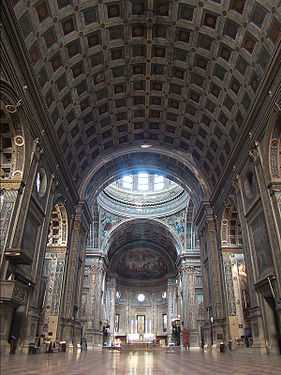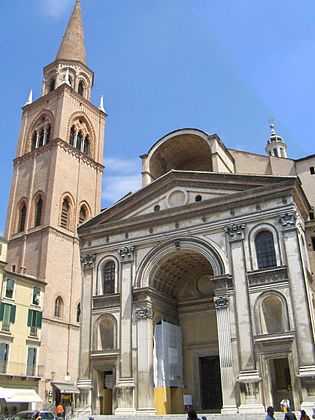Basilica of Sant'Andrea, Mantua
| Basilica di Sant'Andrea | |
|---|---|
|
Façade of Sant'Andrea, Mantua | |
| Basic information | |
| Location |
|
| Geographic coordinates | 45°9′32″N 10°47′39″E / 45.15889°N 10.79417°ECoordinates: 45°9′32″N 10°47′39″E / 45.15889°N 10.79417°E |
| Affiliation | Roman Catholic |
| Ecclesiastical or organizational status | Minor basilica, co-cathedral[1][2] |
| Leadership | Bishop Roberto Busti |
| Website |
www |
| Architectural description | |
| Architect(s) | Leon Battista Alberti |
| Architectural type | Church |
| Architectural style | Renaissance |
| Groundbreaking | 1472 |
| Completed | 1790 |
The Basilica of Sant'Andrea is a Roman Catholic co-cathedral and minor basilica in Mantua, Lombardy (Italy). It is one of the major works of 15th-century Renaissance architecture in Northern Italy. Commissioned by Ludovico III Gonzaga, the church was begun in 1462 according to designs by Leon Battista Alberti on a site occupied by a Benedictine monastery, of which the bell tower (1414) remains. The building, however, was finished only 328 years later. Though later changes and expansions altered Alberti's design, the church is still considered to be one of Alberti's most complete works. It looms over the Piazza Mantegna.
Architecture

The façade, built abutting a pre-existing bell tower (1414), is based on the scheme of the ancient Arch of Titus. It is largely a brick structure with hardened stucco used for the surface. It is defined by a large central arch, flanked by Corinthian pilasters. There are smaller openings to the right and left of the arch. A novel aspect of the design was the integration of a lower order, comprising the fluted Corinthian columns, with a giant order, comprising the taller, unfluted pilasters. The whole is surmounted by a pediment and above that a vaulted structure, the purpose of which is not exactly known, but presumably to shade the window opening into the church behind it.
An important aspect of Alberti’s design was the correspondence between the façade and the interior elevations, both elaborations of the triumphal arch motif, the arcades, like the facade, having alternating high arches and much lower square topped openings.
The nave is roofed by a barrel vault, one of the first times such a form was used in such a monumental scale since antiquity, and probably modeled on the Basilica of Maxentius in Rome. Alberti possibly planned for the vault to be coffered, much like the shorter barrel vault of the entrance, but lack of funds led to the vault being constructed as a simple barrel vault with the coffers then being painted on. Originally, the building was planned without a transept, and possibly even without a dome. This phase of construction more or less ended in 1494.
In 1597, the lateral arms were added and the crypt finished. The massive dome (1732–1782) was designed by Filippo Juvarra, and the final decorations on the interior added under Paolo Pozzo and others in the late 18th and early 19th centuries.[3]
Relic of the Holy Blood

The purpose of the new building was to receive the pilgrims who visited it during the feast of Ascension when a vial, that the faithful argue contains the Blood of Christ, is brought up from the crypt below through a hole in the floor directly under the dome. The relic, called Preziosissimo Sangue di Cristo ("Most Precious Blood of Christ"), is preserved in the Sacred Vessels, according to the tradition was brought to Mantua by the Roman centurion Longinus, who had scooped up the earth containing the blood. The relic was "rediscovered" (secunda inventio) ca. 1049. Pope Leo IX recognized this relic as authentic in 1053. It was highly venerated during the Renaissance. The shrines are displayed only on the Good Friday, to the faithful and then brought out along the streets of Mantua in a procession.
Other aspects
In the belltower there are five bells (A, C#, E, F#, A) cast in the 19th century. One of the chapels houses the tomb of the early Renaissance painter Andrea Mantegna, with a bronze figure of him, by Gianmarco Cavalli; his chapel has a Holy Family by him. Other artworks in the chapels include frescoes of Giulio Romano's school (a work by Giulio is currently a copy) and Correggio.
Burials
Notes
- ↑ Basilica Concattedrale di S. Andrea - complesso
- ↑ Basilica di S. Andrea Apostolo on GCatholic.org
- ↑ Franco Borsi. Leon Battista Alberti. (New York: Harper & Row, 1977)
See also
References
- Johnson, Eugene J. (1975). S. Andrea in Mantua : the building history. University Park: Pennsylvania State University Press. ISBN 0-271-01186-6.
- Il Sant'Andrea di Mantova e Leon Battista Alberti (in Italian). Mantova: Ed. della Bibl. Comunale. 1974. OCLC 2549495.
- La reliquia del sangue di Cristo: Mantova, l'Italia e l'Europa ad tempo di Leone IX, ed. Glauco Maria Cantarella, Verona: Scripta, 2012.
External links
- Alberti's Sant' Andrea in Mantua, Heather Horton, article at Smarthistory
- Basilica Concattedrale di S. Andrea - complesso (Italian)
- Mantua tourist guide Mantua tourist guide
| Wikimedia Commons has media related to Sant'Andrea (Mantua). |
| ||||||
